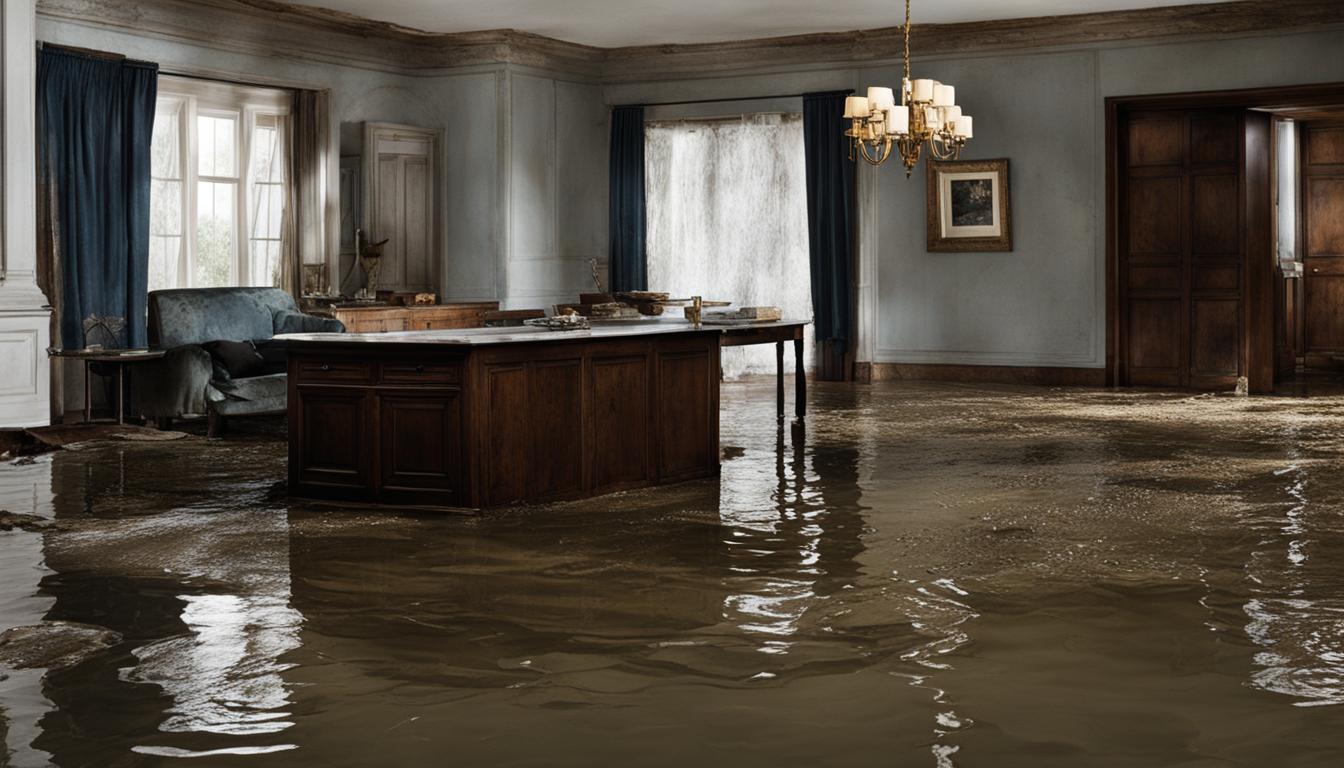Water damage is a serious problem that can have long-lasting effects on your home or business. It can cause structural damage, mold growth, and other health hazards. But how do you know if the water damage is permanent?
In this article, we will discuss the signs of permanent water damage, the causes and effects of water damage, and the steps you can take to prevent and mitigate it. By understanding these key factors, you will be better equipped to identify and respond to water damage in your home or business.
Key Takeaways:
- Water damage can have long-lasting effects on your property and your health
- Immediate response is crucial in mitigating water damage and preventing permanent damage
- Signs of permanent water damage include mold growth, discoloration, and a musty odor
- Professional restoration services can help repair the damage caused by water
- Taking preventative measures and regular inspections can help minimize the risks of water damage
Understanding Water Damage
Water damage can be caused by a wide range of factors, each with their own unique effects on your property. Some of the most common causes of water damage include:
| Cause | Effect |
|---|---|
| Leaking pipes | Water stains, musty odors, mold growth |
| Natural disasters (e.g. floods, storms) | Structural damage, contaminated water, electrical hazards |
| Malfunctioning appliances (e.g. washing machines, dishwashers) | Pooling water, damaged flooring, electrical fires |
These causes can lead to a range of effects, from cosmetic issues like water stains and discoloration, to more serious concerns such as structural damage and mold growth. It’s important to understand the potential severity of water damage, as quick action is often necessary to prevent permanent damage.
Tip: It’s important to regularly inspect your property for signs of water damage, including musty odors, pooling water, and stains on walls or ceilings.
Despite your best efforts, water damage is not always preventable. In the next section, we will discuss the importance of taking immediate action when dealing with water damage and steps you can take to minimize the potential for permanent damage.
Immediate Response to Water Damage
Water damage can quickly become permanent, so it’s crucial to take immediate action to prevent further harm.
First, turn off any electrical devices in the affected area to avoid electrocution. Then, try to locate the source of the water and stop it if possible. Once you’ve done this, you can begin to assess the damage and take steps to minimize it.
Depending on the extent of the water damage, you may be able to handle it yourself. If you do, be sure to wear protective clothing and use proper equipment. For more significant damage, it’s best to seek the help of water damage restoration professionals who can provide the necessary expertise and equipment to mitigate the damage.
| Prevention Measures | Explanation |
|---|---|
| Regular Maintenance | Regular maintenance checks can identify potential problems before they escalate. |
| Proper Insulation | Properly insulating pipes and other potential water sources can prevent them from freezing and bursting. |
| Keep Gutters Clear | Keeping gutters clear of debris can prevent them from overflowing and causing water damage. |
| Invest in a Water Detection System | A water detection system can alert you to potential water damage before it becomes a larger problem. |
By implementing these prevention measures and responding quickly to any water damage you encounter, you can help minimize the potential for permanent damage and protect your property.
Assessing the Extent of Water Damage
It is important to assess the extent of water damage to determine the best course of action for restoration. The severity of the damage can range from minor water stains to flooding that requires extensive repairs. To assess the extent of the damage, start by locating the source of the water and determining the type of water involved.
Note: Identifying the type of water involved is crucial in determining the extent of the damage because different types of water can cause varying degrees of damage. For instance, clean water from a burst pipe is less harmful than water from a sewage backup or flood.
Next, evaluate the affected areas and check for signs of mold or mildew growth, warping, discoloration, and dampness. Take pictures to document the extent of the damage, including visible signs of damage and hidden areas, to help with insurance claims.
Based on your assessment, determine the extent of the damage and whether you need professional assistance. The severity of the damage can range from minor to major, affecting different areas of the property. It is best to consult with a professional to help with the assessment and provide restoration solutions.
If you need professional assistance, it is best to contact a water damage restoration company. They have the expertise and equipment to accurately identify the extent of the damage and provide mitigation and restoration services.
Signs of Permanent Water Damage
If you’re dealing with water damage, it’s essential to recognize the signs of permanent damage. Ignoring these signs could lead to further damage to your property and health. Here are some of the most common signs:
| Signs of Permanent Water Damage | Description |
|---|---|
| Discoloration | If you notice yellowish or brownish stains on your walls, ceiling, or floor, it could mean that the water has seeped through and caused discoloration. |
| Odor | A musty smell can be an indication of permanent water damage. This smell occurs when mold and mildew start to grow due to the moisture that remains after the water damage. |
| Warping | If surfaces, such as wooden floors or cabinets, start to warp or bend, it’s often a clear sign of severe water damage. These surfaces should be replaced or restored as soon as possible. |
| Structural Damage | Water damage can cause structural damage to your home, such as sagging ceilings or walls. If you notice any of these signs, it’s essential to have a professional assess the damage. |
If you notice any of these signs, it’s crucial to address the issue immediately to prevent further damage. Attempting to restore the damage yourself can lead to additional problems, such as mold growth or incomplete restoration. Instead, seek professional restoration services to ensure that the damage is properly mitigated and repaired.
Restoring Water Damage
If you are dealing with water damage, it is imperative to seek professional water damage restoration services to prevent further damage and potential health hazards. A professional company has the knowledge and equipment to assess, mitigate, and repair the damage caused by water. The restoration process involves specific steps and techniques that need to be executed proficiently for the best results.
The first step is to assess the extent of the damage, as this will determine the restoration procedure required. Water damage restoration professionals will use moisture meters, infrared cameras, and other specialized equipment to detect the level of moisture saturation and help pinpoint water damage areas. They will also identify the source of the water and check for any hidden damage that may not be visible.
Next, the mitigation process begins, which involves removing any remaining standing water and drying the affected areas. This process is crucial to prevent mold growth, which can occur within 24-48 hours of water exposure. Water damage restoration professionals will use dehumidifiers, fans, and other equipment to dry the area quickly and efficiently.
After completing the mitigation process, restoration can begin, which involves repairing or replacing damaged materials such as drywall, flooring, and appliances. This process also includes deodorization, disinfection, and cleaning to eliminate any bacteria, mildew, or mold presence.
By hiring professional water damage restoration services, you can ensure that your property is restored quickly and efficiently, minimizing the risk of further damage and potential health hazards. Make sure to select a certified and experienced restoration company that follows industry standards and protocols for the best results.
Conclusion
Water damage can be a costly and devastating issue for homeowners. The key to preventing permanent damage is to act quickly, addressing the issue as soon as it is detected. Remember to regularly inspect your home for any signs of water damage, such as discoloration or unusual odors.
If you do suspect water damage, it’s important to assess the extent of the damage and take immediate action to prevent further harm. While some cases of water damage can be resolved with DIY solutions, it’s important to recognize the signs of permanent damage and seek professional restoration services when necessary.
In summary, by understanding the effects of water damage, taking immediate preventative measures, and recognizing the signs of permanent damage, you can protect your home and minimize the potentially devastating consequences of water damage.
FAQ
Is water damage permanent?
Water damage can be permanent depending on several factors such as the extent of the damage, the type of materials affected, and the time it takes to address the issue. In some cases, immediate action can prevent permanent damage.
What are the signs of water damage?
Some common signs of water damage include water stains or discoloration on walls or ceilings, musty odors, warped or buckled flooring, peeling paint or wallpaper, and the presence of mold or mildew. These signs can indicate the need for further investigation and potential repairs.
What causes water damage?
Water damage can be caused by various factors, including plumbing leaks, burst pipes, roof leaks, flooding, appliance malfunctions, and sewage backups. Understanding the source of the water damage is crucial in determining the appropriate course of action for restoration.
How should I respond to water damage immediately?
It is essential to take immediate action when dealing with water damage. Start by shutting off the water supply if possible, and then begin removing excess water using towels or a wet vacuum. Contact a professional water damage restoration company to assess the situation and prevent further damage.
How can I assess the extent of water damage?
To assess the extent of water damage, start by visually inspecting the affected areas for visible signs of damage. Use a moisture meter or thermal imaging camera to identify hidden moisture. It is also helpful to consult with a professional who can provide a thorough evaluation and recommend appropriate restoration measures.
What are the signs of permanent water damage?
Signs of permanent water damage may include significant structural deterioration, persistent mold growth, foul odors even after drying, or irreparable damage to materials such as drywall or hardwood flooring. If you notice these signs, it is advisable to seek professional water damage restoration services.
Why is professional water damage restoration important?
Professional water damage restoration services are crucial to ensure thorough mitigation, repair, and restoration of the affected areas. Professionals have the expertise, equipment, and knowledge to properly assess the damage, effectively remove moisture, prevent mold growth, and restore the property to its pre-damaged condition.







